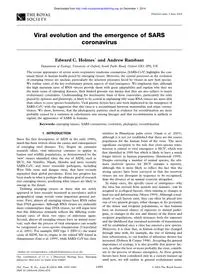
2004 Viral evolution and the emergence of SARS coronavirus PDF
Preview 2004 Viral evolution and the emergence of SARS coronavirus
Published online 2 June 2004 Viral evolution and the emergence of SARS coronavirus Edward C. Holmes* and Andrew Rambaut Department of Zoology, University of Oxford, South Parks Road, Oxford OX1 3PS, UK The recent appearance of severe acute respiratory syndrome coronavirus (SARS-CoV) highlights the con- tinual threat to human health posed by emerging viruses. However, the central processes in the evolution of emerging viruses are unclear, particularly the selection pressures faced by viruses in new host species. We outline some of the key evolutionary genetic aspects of viral emergence. We emphasize that, although the high mutation rates of RNA viruses provide them with great adaptability and explain why they are the main cause of emerging diseases, their limited genome size means that they are also subject to major evolutionary constraints. Understanding the mechanistic basis of these constraints, particularly the roles played by epistasis and pleiotropy, is likely to be central in explaining why some RNA viruses are more able than others to cross species boundaries. Viral genetic factors have also been implicated in the emergence of SARS-CoV, with the suggestion that this virus is a recombinant between mammalian and avian corona- viruses. We show, however, that the phylogenetic patterns cited as evidence for recombination are more probably caused by a variation in substitution rate among lineages and that recombination is unlikely to explain the appearance of SARS in humans. Keywords: emerging viruses; SARS coronavirus; evolution; phylogeny; recombination 1. INTRODUCTION Since the first descriptions of AIDS in the early 1980s, much has been written about the causes and consequences of emerging viral diseases. Yet, despite an extensive research effort, viral infections continue to appear in human and wildlife populations, as demonstrated by the ‘new’ viruses identified since the rise of AIDS, such as HCV, Sin Nombre, Nipah, Hendra and most recently SARS-CoV, and more venerable pathogens, including West Nile virus and dengue virus, that have recently expanded their global prevalence. Even less progress has been made in what is perhaps the ultimate goal of research into emerging viruses, predicting what viruses are likely to emerge in the future. Defining emerging viruses as those that are newly appeared or have recently increased in prevalence and/or geographical range reveals some important general pat- terns. First, almost all emerging viruses have RNA rather than DNA genomes. Although RNA viruses are ordinarily more commonplace than DNA viruses, we will argue later that this difference primarily reflects the differing evolu- tionary rates of these two types of infectious agent. Second, almost all emerging viruses have an animal reser- voir, such that the process of viral emergence can usually be categorized as cross-species transmission (Cleaveland et al. 2001). For example, HIV type 1 (HIV-1), the major cause of AIDS, has its origins in the related SIV found in chimpanzees (Gao et al. 1999), while SARS-CoV has close * Author for correspondence (
